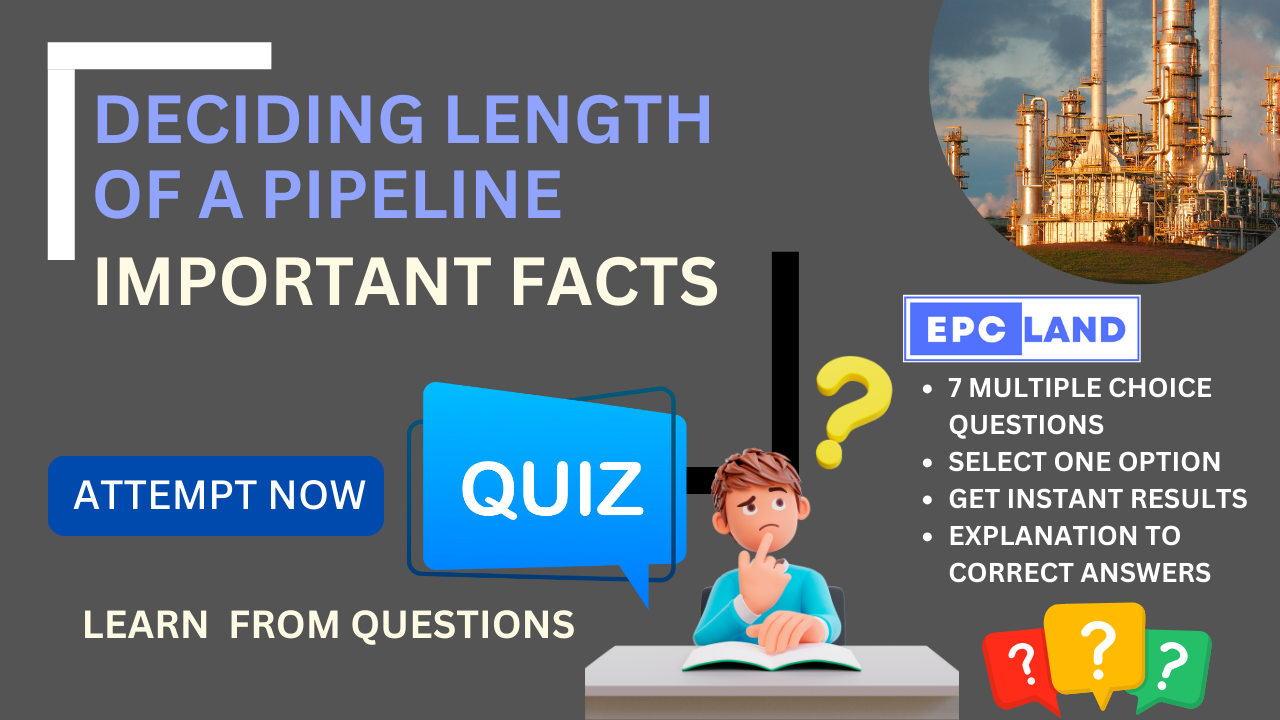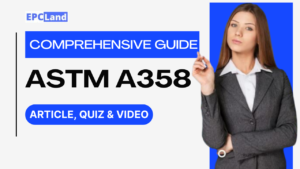1. What is the design pressure of a pipeline?
The design pressure of a pipeline is:
Explanation: The design pressure of a pipeline is the maximum pressure that the pipeline is designed to withstand (Option C).
2. How does acceptable pressure drop influence pipeline length?
The acceptable pressure drop:
Explanation: Higher acceptable pressure drops allow for longer pipelines, but they also reduce the efficiency of the pipeline (Option B).
3. How does diameter influence pipeline length?
The diameter of the pipeline determines:
Explanation: The diameter of the pipeline determines how much fluid can flow through the pipeline (Option D).
4. Why is temperature profile important in pipeline design?
The temperature profile of the pipeline:
Explanation: The temperature profile of the pipeline affects the pressure and flow of the fluid (Option D).
5. Which equation is used for calculating liquid flow parameters?
The equation H/L = fLv^2/2D is used for calculating:
Explanation: The equation H/L = fLv^2/2D is used for calculating liquid flow parameters (Option B).
6. What is the Reynolds number equation for gas flow in fully turbulent conditions?
The Reynolds number equation for turbulent gas flow is:
Explanation: The Reynolds number equation for turbulent gas flow is Q = 432.7 * (T_k / P_n) * [(P^2 – P_y^2 – E) / (GLT_mZ_m)]^(0.5 * tau) * D_cos^7 (Option B).
7. Which equation is used in the Colebrook-White equation for friction factor?
The Colebrook-White equation for friction factor uses the equation:
Explanation: The Colebrook-White equation for friction factor uses the equation f = -737.02 * (Re^-1.413 – 1.413/Re + 3.70) (Option C).
Short Article
Factors that influence the length of a pipeline
- Design pressure: The design pressure of a pipeline is the maximum pressure that the pipeline is designed to withstand. Higher design pressures require thicker pipe walls, which increases the cost of the pipeline.
- Acceptable pressure drop: The acceptable pressure drop is the maximum amount of pressure that is allowed to drop over the length of the pipeline. Higher acceptable pressure drops allow for longer pipelines, but they also reduce the efficiency of the pipeline.
- Diameter: The diameter of the pipeline determines how much fluid can flow through the pipeline. Larger diameter pipelines can transport more fluid, but they are also more expensive to construct.
- Wall thickness: The wall thickness of the pipeline must be sufficient to withstand the design pressure and internal forces. Thicker pipe walls can withstand higher pressures, but they also increase the cost of the pipeline.
- Temperature profile: The temperature profile of the pipeline describes how the temperature of the fluid changes along the length of the pipeline. Temperature changes can affect the pressure and flow of the fluid, so it is important to consider the temperature profile when designing a pipeline.
Equations used in calculating the basic flow parameters for gas and liquid pipelines
The following equations are used in calculating the basic flow parameters for gas and liquid pipelines:
Liquid flow
H/L = fLv^2/2D
where:
- H/L is the head loss per unit length of pipeline
- f is the friction factor
- L is the length of the pipeline
- v is the velocity of the fluid
- D is the diameter of the pipeline
Gas flowrate equations (fully turbulent)
- For laminar flow (Re<2100):
f = 64/Re
where:
- Re is the Reynolds number
- For turbulent flow (Re>4000):
Q = 432.7 * (T_k / P_n) * [(P^2 - P_y^2 - E) / (GLT_mZ_m)]^(0.5 * tau) * D_cos^7
where:
- Q is the gas flowrate
- T_k is the base temperature
- P_n is the base pressure
- P is the pressure
- P_y is the yield pressure
- E is the efficiency factor
- G is the gas specific gravity
- L is the length of the pipeline
- T_m is the average temperature
- Z_m is the average compressibility factor
- tau is the friction factor exponent
- D_cos is the inside diameter of the pipeline
Colebrook-White equation
f = -737.02 * (Re^-1.413 - 1.413/Re + 3.70)
where:
- f is the friction factor
- Re is the Reynolds number
Reynolds number
Re = pD * v / mu
where:
- Re is the Reynolds number
- p is the density of the fluid
- D is the diameter of the pipeline
- v is the velocity of the fluid
- mu is the viscosity of the fluid
These equations can be used to calculate the flowrate, pressure drop, and other important parameters for gas and liquid pipelines.
Table of Contents
Don’t miss the Course on Effective Isometrics Management: Check Now
Enrollment Link
Recommended courses (Published on EPCLand)
- Complete Course on Piping Engineering
- Basics of Piping Engineering
- Piping Layout Engineering
- Piping Material Engineering
- Piping Stress Analysis
- Material Requisitions
- Piping Material Specifications
- Valve Material Specifications
- Plant Design & Layouts-OISD 118
- Isometric Management
Library of Technical Articles
Don’t miss out the collection of 15+ articles on following topics:
- Basics of Oil and Gas Industry
- Valves
- Testing
- Tank
- Piping Bulk Items
- Pipe
- Metallurgy
- Piping Materials
- Layout
- Instrumentation
- Heat Exchanger
- Type of Contracts
- Codes and Standards
- ASTM Standards
- Articles on Piping Specialty Items
Video details of Complete Course on Piping Engineering
Why Enroll in the EPCLand
Proven Track Record– PTR
Activities & Achievements before launching EPCLand
- Published more than 50+ short courses
- 3000+ Enrolments
- More than 3,500,00 Minutes of watch hours in the last 2 years
- 4000+ Students in 100+ Countries
- Rating of 4+ out of 5
- 1000+ YouTube Videos
- 8K+ Subscribers
What Students will Learn
- Codes & Standards of the Energy Sector
- Piping Material Engineering
- Piping Layout Engineering
- Stress Analysis
Interesting facts
- All the published courses have been developed by Industry Experts with more than 2 decades of experience
- Content is based on Practical experience and real-time problems.
- Content is designed and organized in such a manner that it can be easily grabbed.
- Complete website, Blogs and Quiz sections are Planned, Designed and published by myself (About me: Atul Singla)
- Complete flexibility of Time & Location, Students can access the content from anywhere & anytime
- Moreover, once enrolled, the content can be access as many times as you want, which helps in understand the fundamentals in a better way.
Conclusion
In conclusion, our courses are meticulously crafted by industry experts with over two decades of hands-on experience. The content is rooted in practical knowledge, addressing real-time problems. The material is thoughtfully designed and organized for easy comprehension. Every aspect, from the website to blogs and quizzes, has been planned, designed, and executed by Atul Singla, ensuring a comprehensive and seamless learning experience. With the flexibility of accessing the content at any time and from any location, students have the freedom to learn on their terms. Furthermore, enrollment grants unlimited access, allowing learners to revisit the material as often as needed, fostering a deep understanding of the fundamentals.



